Abstract
1. To investigate how intrathoracic pressure affects left ventricular function during normal breathing and positive-pressure ventilation, beat-by-beat measurements of left ventricular stroke volume (LVSV; pulsed Doppler ultrasound), heart rate and blood pressure were made in five normal subjects breathing actively and then undergoing passive positive-pressure ventilation. 2. To assess the within-breath effects of positive-pressure ventilation on left ventricular function in the clinical setting, further measurements were made in six patients sedated, paralysed and ventilated because of brain injuries, who had no disease of the heart or lungs. 3. In the normal subjects, there were minimal phasic variation in LVSV during positive-pressure ventilation with the subject passive. Heart rate and blood pressure also stayed relatively constant throughout the ventilator cycle. During active breathing at the same depth and rate, there were large phasic respiratory variations in LVSV, with the lowest values occurring during inspiration. 4. In the paralysed and unconscious patients, an increase in LVSV was associated with the increase in airway pressure which occurred during lung inflation; however, the phase lag between the rise in airway pressure and the rise in LVSV varied widely between patients. These changes occurred whether or not sinus arrhythmia was present. 5. Addition of 4.6 +/- 1 cmH2O of positive end-expiratory pressure (PEEP) did not increase the within-breath LVSV variations, but resulted in a mean depression of LVSV of 5.4% (paired t test, P = 0.035). 6. The smaller variations in LVSV during positive-pressure ventilation compared to normal breathing in the conscious subjects may reflect (a) the smaller magnitude of positive, compared to negative, pleural pressure excursions which accompany a given tidal volume, and (b) an asymmetry between the effects of positive and negative pleural pressure on the heart. 7. The prominent effects of positive-pressure ventilation on LVSV in unconscious patients, compared to the minimal effects seen in ventilated normal subjects, may result from reduced lung compliance and a degree of pulmonary vascular congestion in the patients which was undetectable clinically or radiologically.
Full text
PDF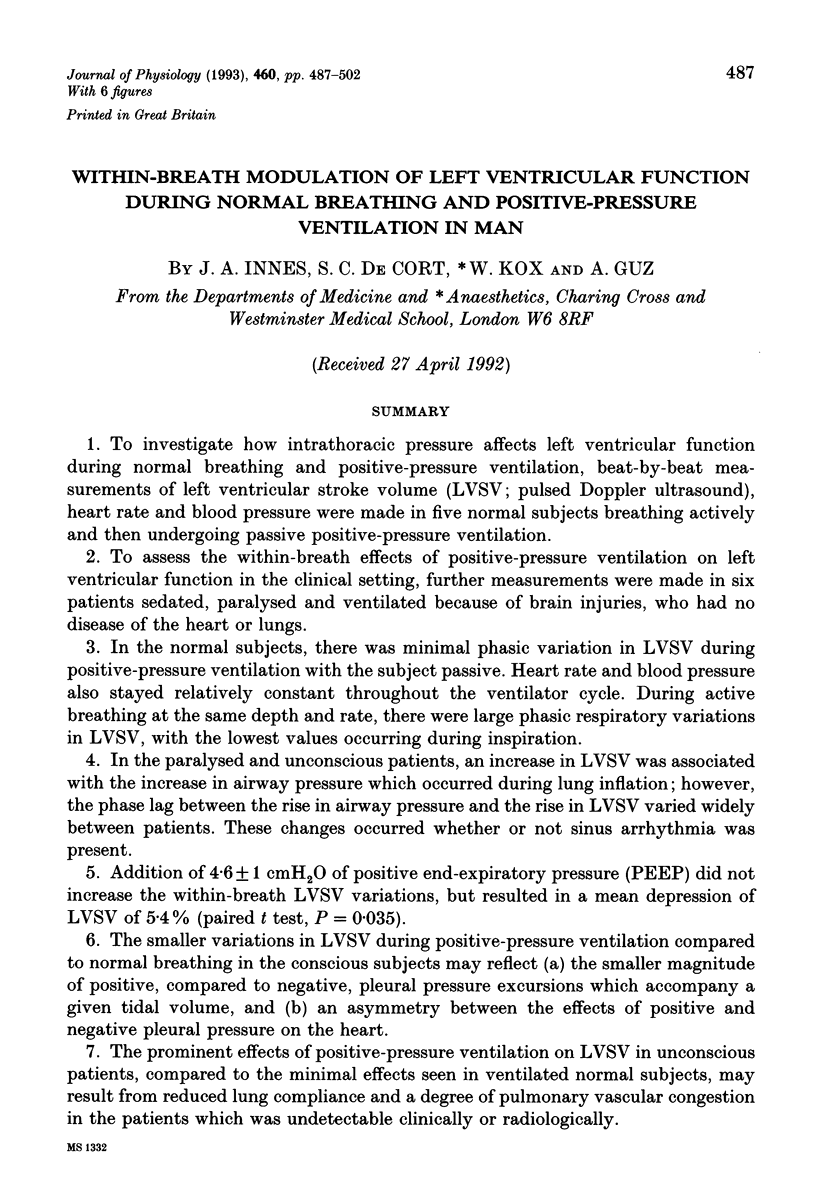

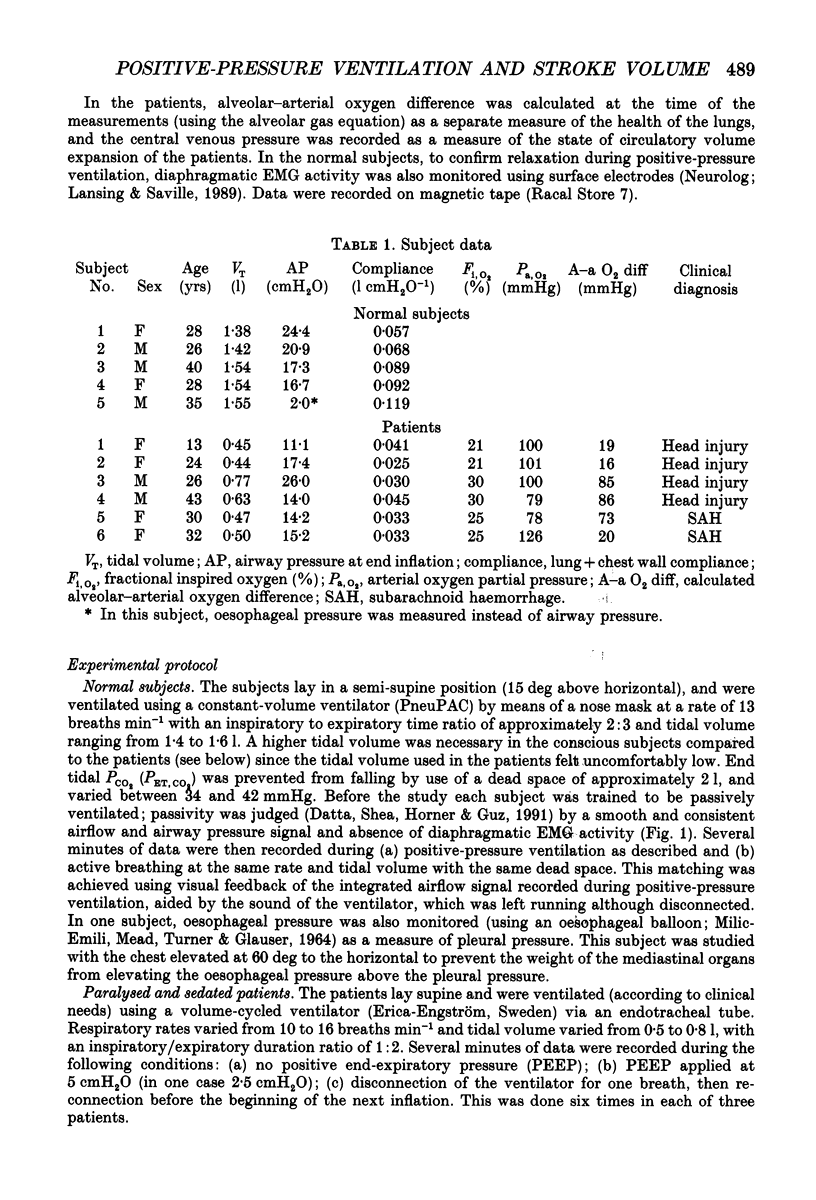
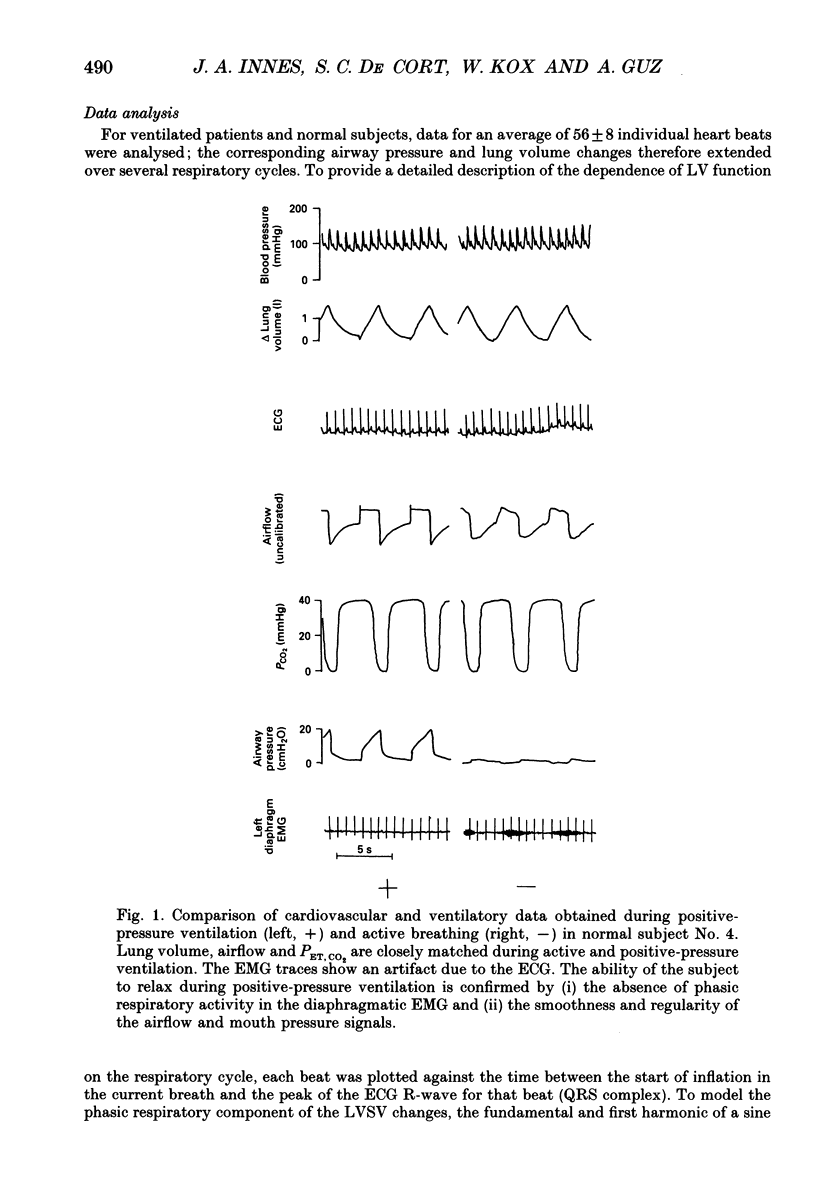
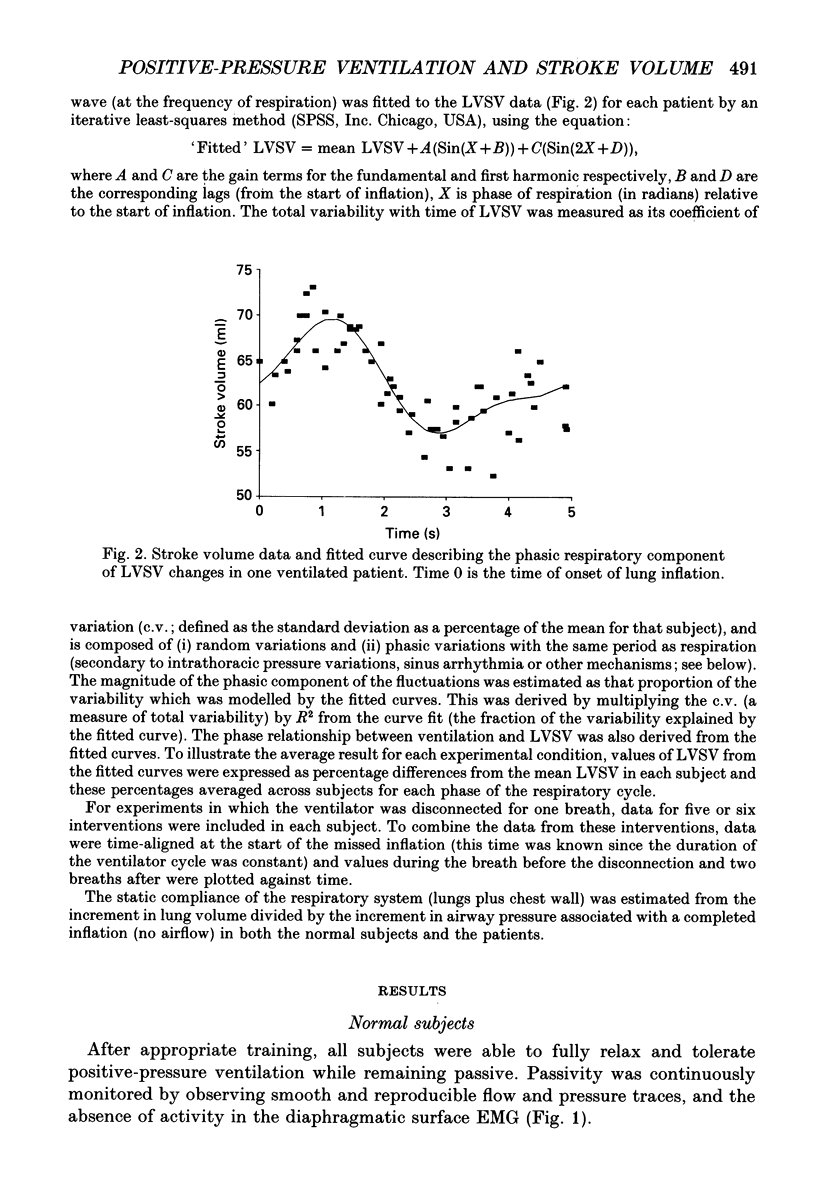
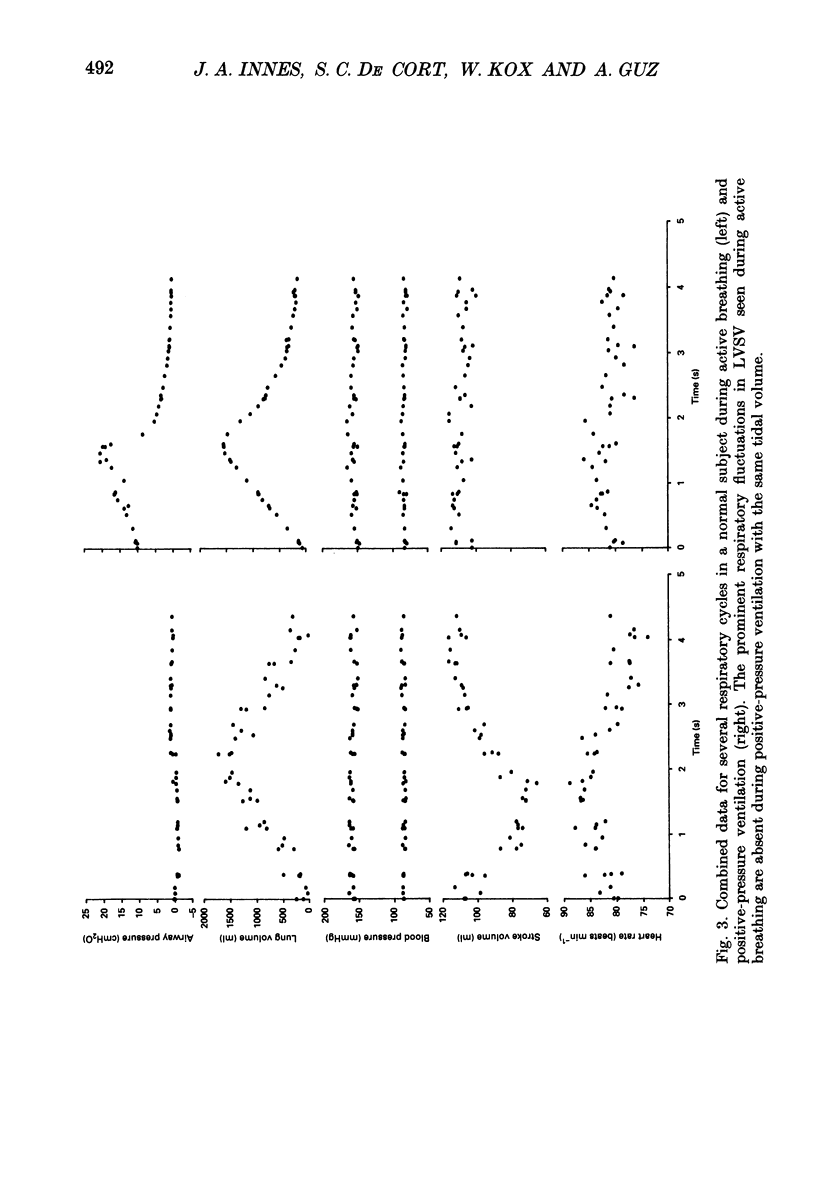

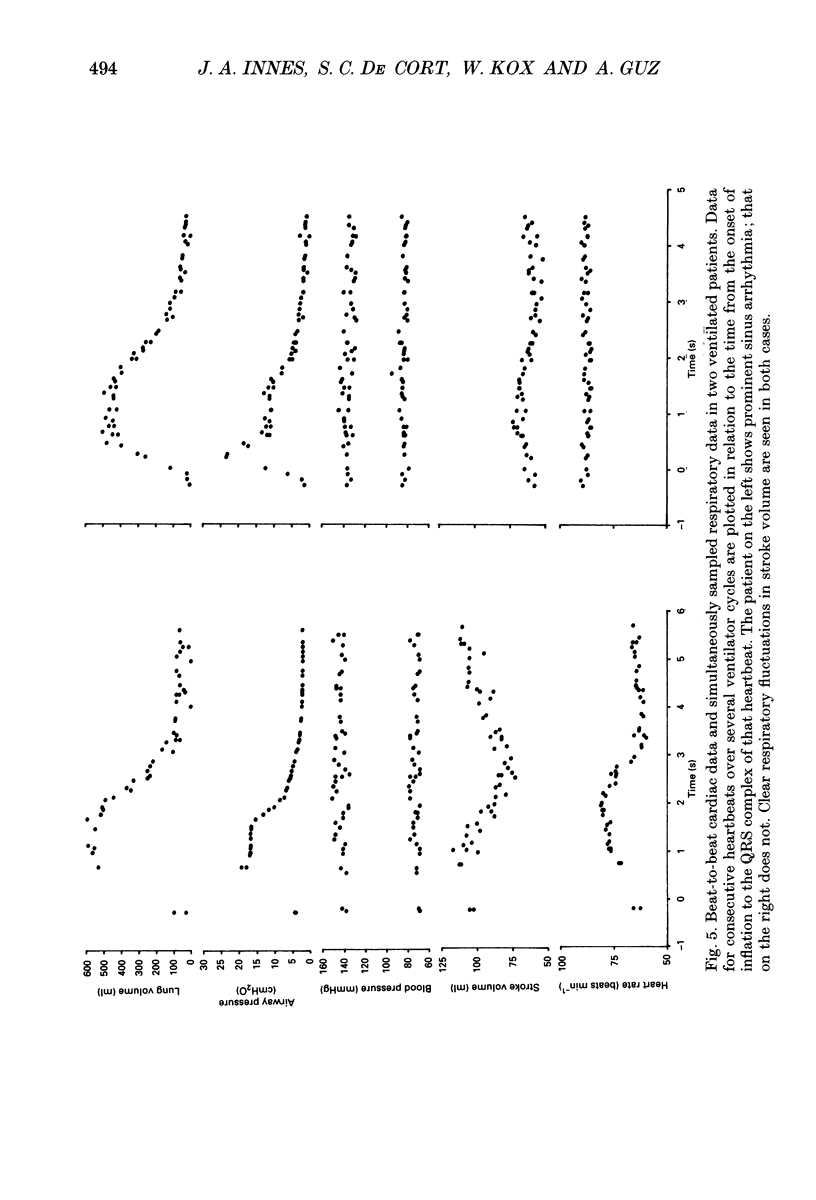
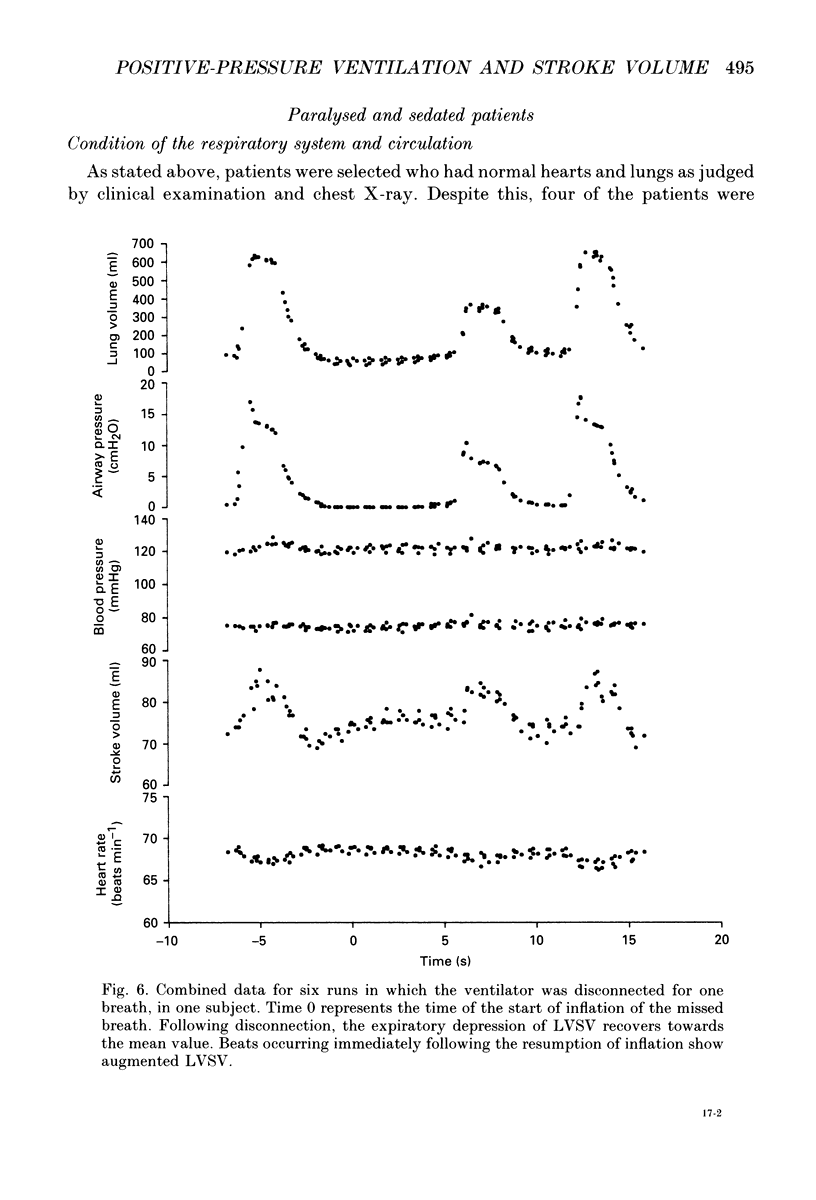

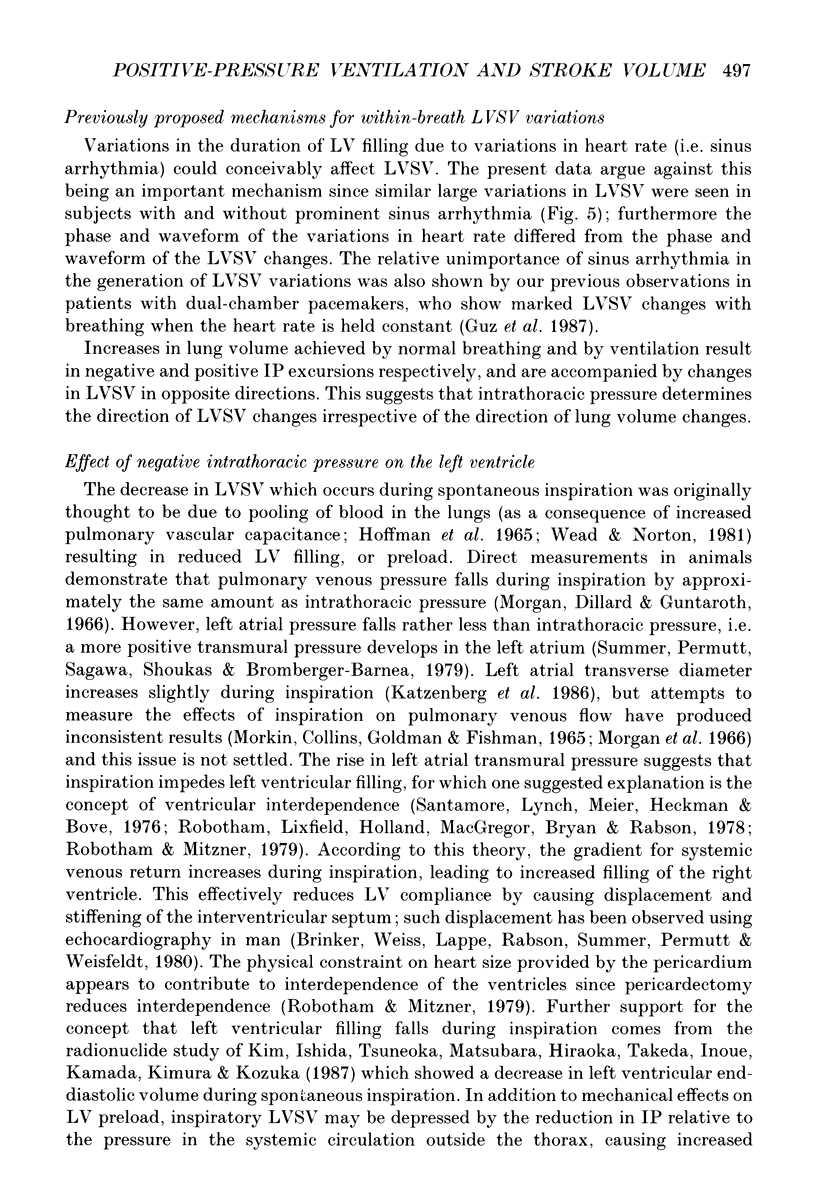

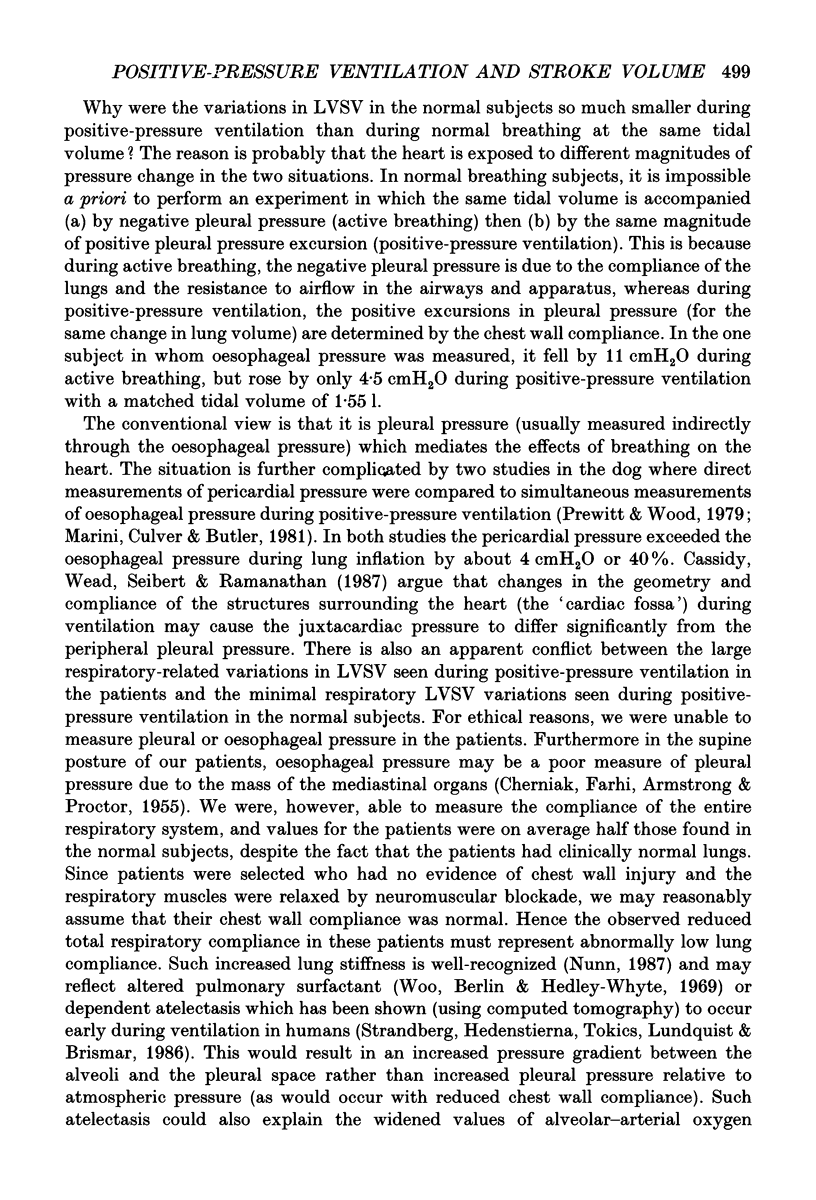
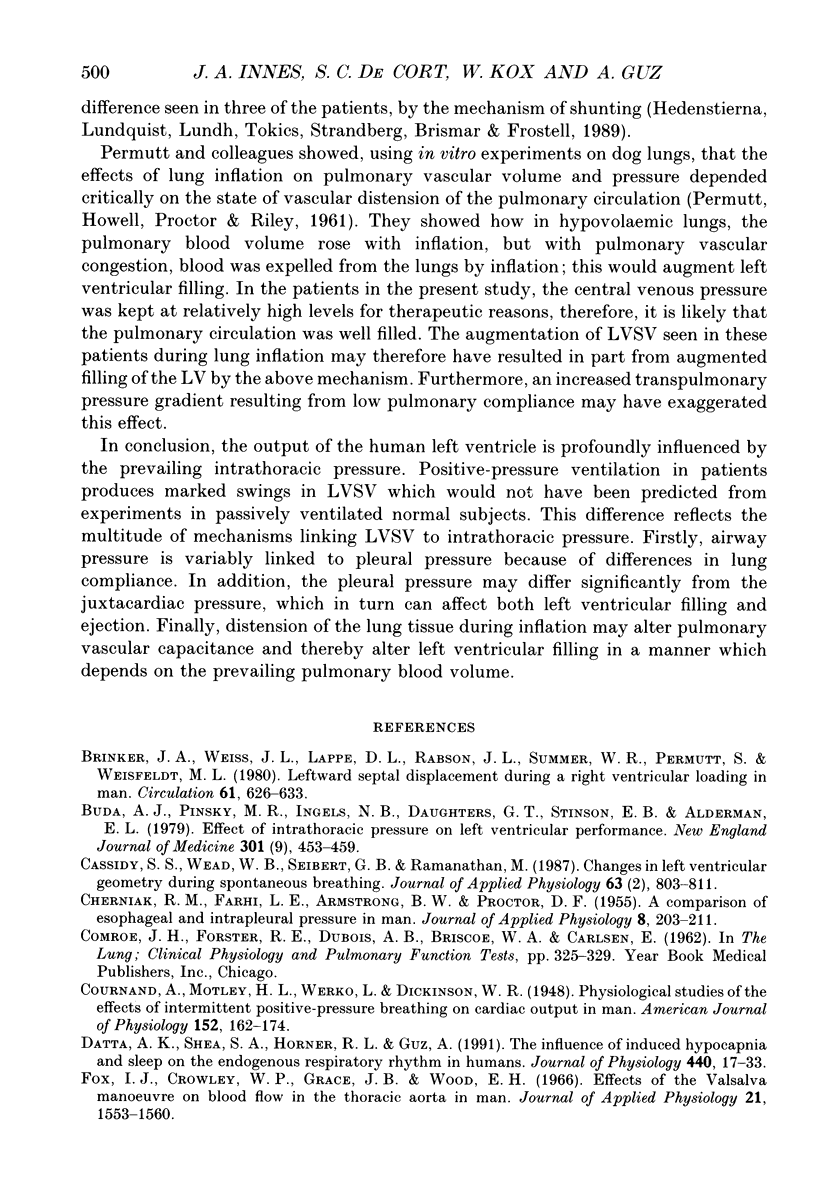
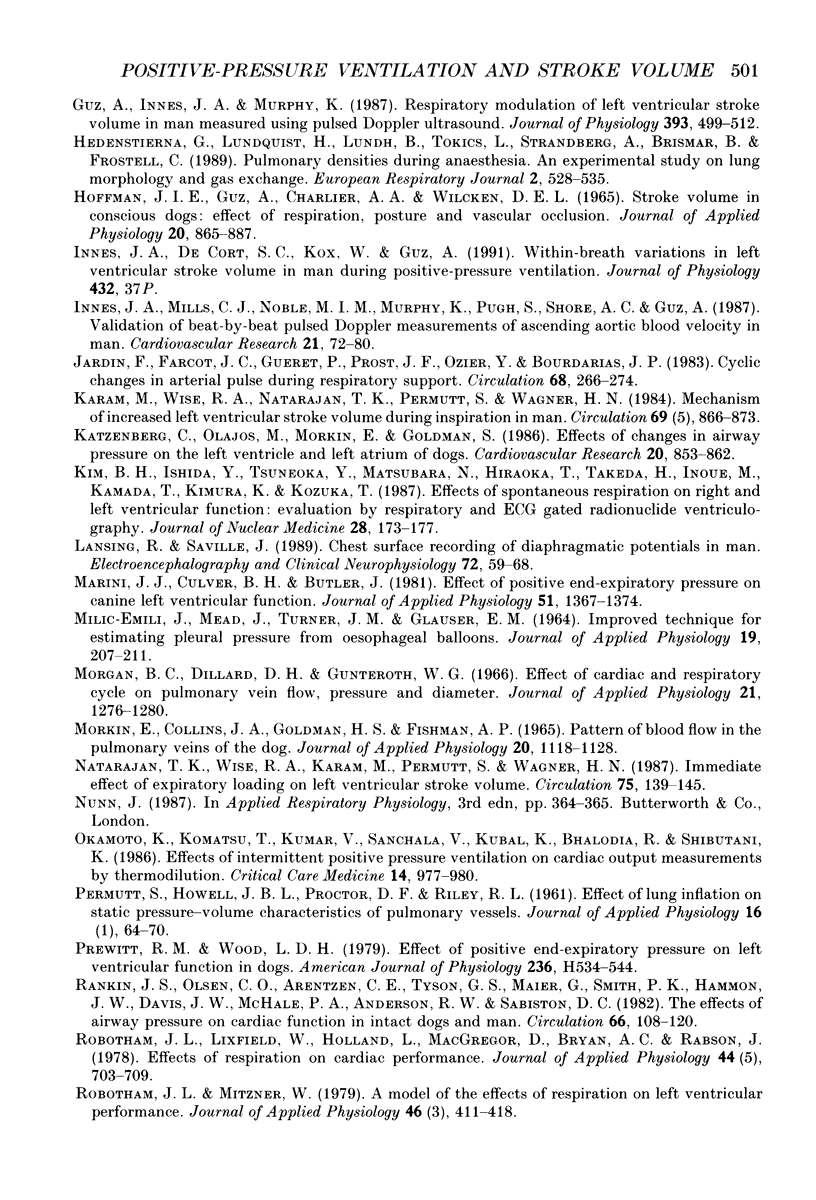
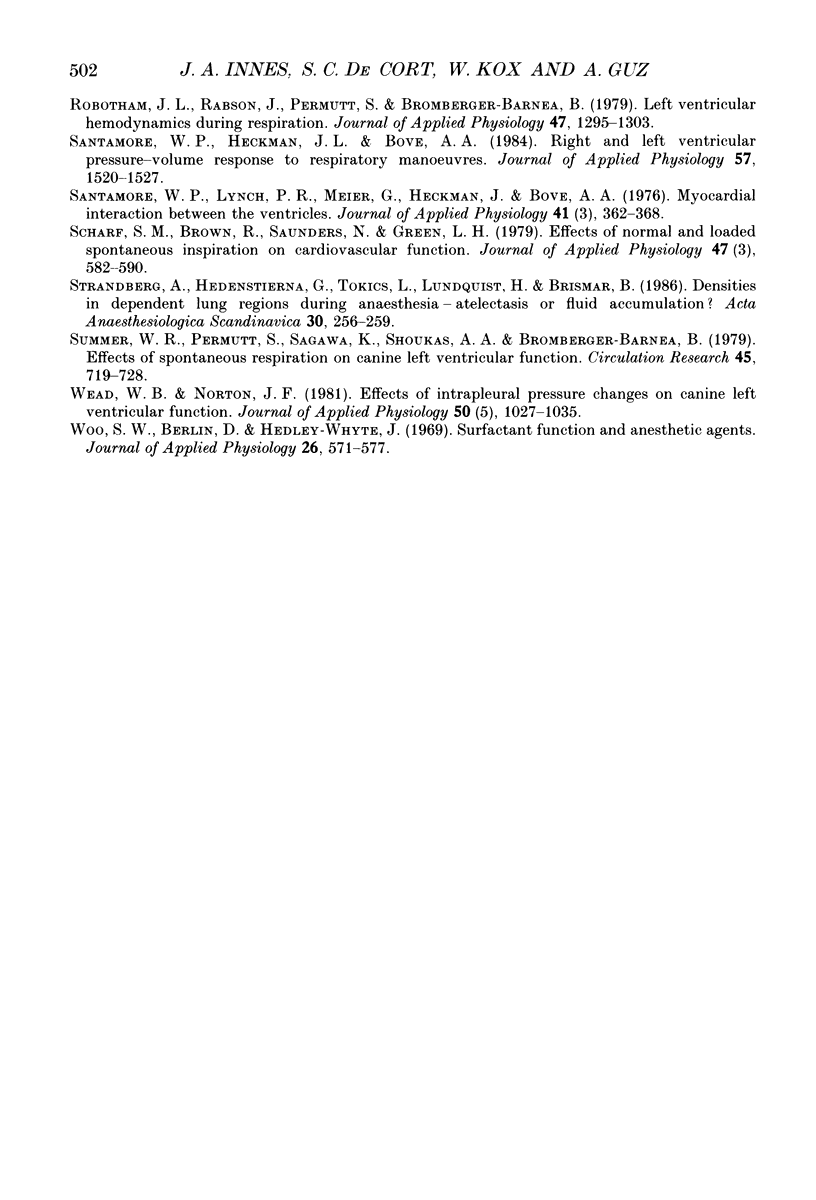
Selected References
These references are in PubMed. This may not be the complete list of references from this article.
- Brinker J. A., Weiss J. L., Lappé D. L., Rabson J. L., Summer W. R., Permutt S., Weisfeldt M. L. Leftward septal displacement during right ventricular loading in man. Circulation. 1980 Mar;61(3):626–633. doi: 10.1161/01.cir.61.3.626. [DOI] [PubMed] [Google Scholar]
- Buda A. J., Pinsky M. R., Ingels N. B., Jr, Daughters G. T., 2nd, Stinson E. B., Alderman E. L. Effect of intrathoracic pressure on left ventricular performance. N Engl J Med. 1979 Aug 30;301(9):453–459. doi: 10.1056/NEJM197908303010901. [DOI] [PubMed] [Google Scholar]
- CHERNIACK R. M., FARHI L. E., ARMSTRONG B. W., PROCTOR D. F. A comparison of esophageal and intrapleural pressure in man. J Appl Physiol. 1955 Sep;8(2):203–211. doi: 10.1152/jappl.1955.8.2.203. [DOI] [PubMed] [Google Scholar]
- Cassidy S. S., Wead W. B., Seibert G. B., Ramanathan M. Changes in left ventricular geometry during spontaneous breathing. J Appl Physiol (1985) 1987 Aug;63(2):803–811. doi: 10.1152/jappl.1987.63.2.803. [DOI] [PubMed] [Google Scholar]
- Datta A. K., Shea S. A., Horner R. L., Guz A. The influence of induced hypocapnia and sleep on the endogenous respiratory rhythm in humans. J Physiol. 1991;440:17–33. doi: 10.1113/jphysiol.1991.sp018693. [DOI] [PMC free article] [PubMed] [Google Scholar]
- Fox I. J., Crowley W. P., Jr, Grace J. B., Wood E. H. Effects of the Valsalva maneuver on blood flow in the thoracic aorta in man. J Appl Physiol. 1966 Sep;21(5):1553–1560. doi: 10.1152/jappl.1966.21.5.1553. [DOI] [PubMed] [Google Scholar]
- Guz A., Innes J. A., Murphy K. Respiratory modulation of left ventricular stroke volume in man measured using pulsed Doppler ultrasound. J Physiol. 1987 Dec;393:499–512. doi: 10.1113/jphysiol.1987.sp016836. [DOI] [PMC free article] [PubMed] [Google Scholar]
- Hedenstierna G., Lundquist H., Lundh B., Tokics L., Strandberg A., Brismar B., Frostell C. Pulmonary densities during anaesthesia. An experimental study on lung morphology and gas exchange. Eur Respir J. 1989 Jun;2(6):528–535. [PubMed] [Google Scholar]
- Hoffman J. I., Guz A., Charlier A. A., Wilcken D. E. Stroke volume in conscious dogs; effect of respiration, posture, and vascular occlusion. J Appl Physiol. 1965 Sep;20(5):865–877. doi: 10.1152/jappl.1965.20.5.865. [DOI] [PubMed] [Google Scholar]
- Innes J. A., Mills C. J., Noble M. I., Murphy K., Pugh S., Shore A. C., Guz A. Validation of beat by beat pulsed Doppler measurements of ascending aortic blood velocity in man. Cardiovasc Res. 1987 Jan;21(1):72–80. doi: 10.1093/cvr/21.1.72. [DOI] [PubMed] [Google Scholar]
- Jardin F., Farcot J. C., Gueret P., Prost J. F., Ozier Y., Bourdarias J. P. Cyclic changes in arterial pulse during respiratory support. Circulation. 1983 Aug;68(2):266–274. doi: 10.1161/01.cir.68.2.266. [DOI] [PubMed] [Google Scholar]
- Karam M., Wise R. A., Natarajan T. K., Permutt S., Wagner H. N. Mechanism of decreased left ventricular stroke volume during inspiration in man. Circulation. 1984 May;69(5):866–873. doi: 10.1161/01.cir.69.5.866. [DOI] [PubMed] [Google Scholar]
- Katzenberg C., Olajos M., Morkin E., Goldman S. Effects of changes in airway pressure on the left ventricle and left atrium of dogs. Cardiovasc Res. 1986 Nov;20(11):853–862. doi: 10.1093/cvr/20.11.853. [DOI] [PubMed] [Google Scholar]
- Kim B. H., Ishida Y., Tsuneoka Y., Matsubara N., Hiraoka T., Takeda H., Inoue M., Kamada T., Kimura K., Kozuka T. Effects of spontaneous respiration on right and left ventricular function: evaluation by respiratory and ECG gated radionuclide ventriculography. J Nucl Med. 1987 Feb;28(2):173–177. [PubMed] [Google Scholar]
- Lansing R., Savelle J. Chest surface recording of diaphragm potentials in man. Electroencephalogr Clin Neurophysiol. 1989 Jan;72(1):59–68. doi: 10.1016/0013-4694(89)90031-x. [DOI] [PubMed] [Google Scholar]
- MILIC-EMILI J., MEAD J., TURNER J. M., GLAUSER E. M. IMPROVED TECHNIQUE FOR ESTIMATING PLEURAL PRESSURE FROM ESOPHAGEAL BALLOONS. J Appl Physiol. 1964 Mar;19:207–211. doi: 10.1152/jappl.1964.19.2.207. [DOI] [PubMed] [Google Scholar]
- Marini J. J., Culver B. H., Butler J. Effect of positive end-expiratory pressure on canine ventricular function curves. J Appl Physiol Respir Environ Exerc Physiol. 1981 Dec;51(6):1367–1374. doi: 10.1152/jappl.1981.51.6.1367. [DOI] [PubMed] [Google Scholar]
- Morgan B. C., Dillard D. H., Guntheroth W. G. Effect of cardiac and respiratory cycle on pulmonary vein flow, pressure, and diameter. J Appl Physiol. 1966 Jul;21(4):1276–1280. doi: 10.1152/jappl.1966.21.4.1276. [DOI] [PubMed] [Google Scholar]
- Natarajan T. K., Wise R. A., Karam M., Permutt S., Wagner H. N., Jr Immediate effect of expiratory loading on left ventricular stroke volume. Circulation. 1987 Jan;75(1):139–145. doi: 10.1161/01.cir.75.1.139. [DOI] [PubMed] [Google Scholar]
- Okamoto K., Komatsu T., Kumar V., Sanchala V., Kubal K., Bhalodia R., Shibutani K. Effects of intermittent positive-pressure ventilation on cardiac output measurements by thermodilution. Crit Care Med. 1986 Nov;14(11):977–980. doi: 10.1097/00003246-198611000-00014. [DOI] [PubMed] [Google Scholar]
- PERMUTT S., HOWELL J. B., PROCTOR D. F., RILEY R. L. Effect of lung inflation on static pressure-volume characteristics of pulmonary vessels. J Appl Physiol. 1961 Jan;16:64–70. doi: 10.1152/jappl.1961.16.1.64. [DOI] [PubMed] [Google Scholar]
- Prewitt R. M., Wood L. D. Effect of positive end-expiratory pressure on ventricular function in dogs. Am J Physiol. 1979 Apr;236(4):H534–H544. doi: 10.1152/ajpheart.1979.236.4.H534. [DOI] [PubMed] [Google Scholar]
- Rankin J. S., Olsen C. O., Arentzen C. E., Tyson G. S., Maier G., Smith P. K., Hammon J. W., Jr, Davis J. W., McHale P. A., Anderson R. W. The effects of airway pressure on cardiac function in intact dogs and man. Circulation. 1982 Jul;66(1):108–120. doi: 10.1161/01.cir.66.1.108. [DOI] [PubMed] [Google Scholar]
- Robotham J. L., Lixfeld W., Holland L., MacGregor D., Bryan A. C., Rabson J. Effects of respiration on cardiac performance. J Appl Physiol Respir Environ Exerc Physiol. 1978 May;44(5):703–709. doi: 10.1152/jappl.1978.44.5.703. [DOI] [PubMed] [Google Scholar]
- Robotham J. L., Mintzner W. A model of the effects of respiration on left ventricular performance. J Appl Physiol Respir Environ Exerc Physiol. 1979 Mar;46(3):411–418. doi: 10.1152/jappl.1979.46.3.411. [DOI] [PubMed] [Google Scholar]
- Robotham J. L., Rabson J., Permutt S., Bromberger-Barnea B. Left ventricular hemodynamics during respiration. J Appl Physiol Respir Environ Exerc Physiol. 1979 Dec;47(6):1295–1303. doi: 10.1152/jappl.1979.47.6.1295. [DOI] [PubMed] [Google Scholar]
- Santamore W. P., Heckman J. L., Bove A. A. Right and left ventricular pressure-volume response to respiratory maneuvers. J Appl Physiol Respir Environ Exerc Physiol. 1984 Nov;57(5):1520–1527. doi: 10.1152/jappl.1984.57.5.1520. [DOI] [PubMed] [Google Scholar]
- Santamore W. P., Lynch P. R., Meier G., Heckman J., Bove A. A. Myocardial interaction between the ventricles. J Appl Physiol. 1976 Sep;41(3):362–368. doi: 10.1152/jappl.1976.41.3.362. [DOI] [PubMed] [Google Scholar]
- Scharf S. M., Brown R., Saunders N., Green L. H. Effects of normal and loaded spontaneous inspiration on cardiovascular function. J Appl Physiol Respir Environ Exerc Physiol. 1979 Sep;47(3):582–590. doi: 10.1152/jappl.1979.47.3.582. [DOI] [PubMed] [Google Scholar]
- Strandberg A., Hedenstierna G., Tokics L., Lundquist H., Brismar B. Densities in dependent lung regions during anaesthesia: atelectasis or fluid accumulation? Acta Anaesthesiol Scand. 1986 Apr;30(3):256–259. doi: 10.1111/j.1399-6576.1986.tb02408.x. [DOI] [PubMed] [Google Scholar]
- Summer W. R., Permutt S., Sagawa K., Shoukas A. A., Bromberger-Barnea B. Effects of spontaneous respiration on canine left ventricular function. Circ Res. 1979 Dec;45(6):719–728. doi: 10.1161/01.res.45.6.719. [DOI] [PubMed] [Google Scholar]
- Wead W. B., Norton J. F. Effects of intrapleural pressure changes on canine left ventricular function. J Appl Physiol Respir Environ Exerc Physiol. 1981 May;50(5):1027–1035. doi: 10.1152/jappl.1981.50.5.1027. [DOI] [PubMed] [Google Scholar]
- Woo S. W., Berlin D., Hedley-Whyte J. Surfactant function and anesthetic agents. J Appl Physiol. 1969 May;26(5):571–577. doi: 10.1152/jappl.1969.26.5.571. [DOI] [PubMed] [Google Scholar]


